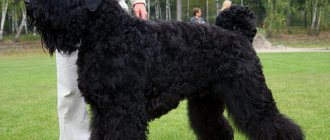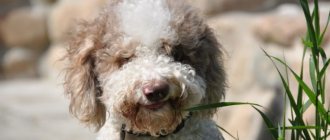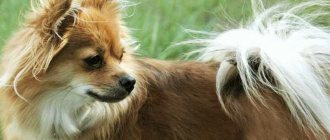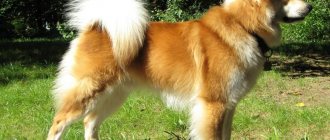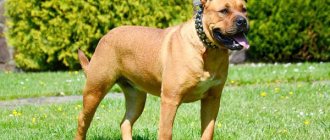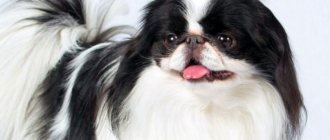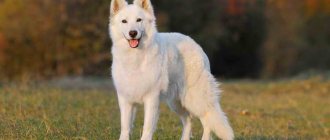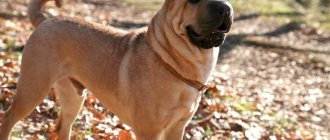a brief description of
- Other names: Portuguese Water Dog, Cão de Água Português, Portie, PWD, water dog, Portuguese;
- Height: up to 57 cm at the withers;
- Weight: up to 27.5 kg;
- Color: black, brown-chocolate solid, white spots on the chest are acceptable in both colors;
- Coat: glossy with a dense undercoat of two types – long with a wavy structure and short, thick;
- Life expectancy: up to 15 years;
- Advantages of the breed: Dogs have a high level of obedience and diligence. He enthusiastically carries out security and guard duty in any weather on water and on land. A typical representative of working dog breeds.
- Difficulties: Secretive individuals, especially dogs tend to hide their poor health and malaise. Most representatives of the breed have a grumpy character.
- Price: $2500.
Portuguese water dog
The Portuguese Water Dog has helped Portuguese sailors for hundreds of years. But, in the second half of the 20th century, technological progress supplanted it and brought it to the brink of extinction. The breed was preserved, but its popularity is low, in contrast to its price. Once exclusively a working dog, today the merman is kept as a companion and friend.
Origin story
The Portuguese Water Dog is a native breed recognized by the FCI. Its origin is often associated with the historical period of the Roman capture of the Iberian Peninsula. This is where the fishing dogs lived. After a short period of time, the court of the Roman Emperor Augustus began to be guarded by large dogs, cut like a lion with characteristic features that outwardly resembled a canis piscator.
The conditions of long-term isolation of dogs in the mountainous suburbs without the participation of other canines formed a stable gene pool as a key feature of the breed. The Portuguese Water Dog is highly identifiable when compared to other aquatic breeds.
Today, there are no more than 10 thousand representatives of the Portuguese Water Dog breed in the world, the price of which is quite high due to the great rarity of the animals.
If we consider that dogs were imported into the territory of the post-Soviet space no more than 8-10 years ago, this explains the lack of offers of puppies and the need for those who want to get a Portuguese to travel to European breeders.
Brief historical background
The Portuguese Water Dog is an ancient working dog breed that is considered indigenous. It appeared in Portugal back in the Middle Ages (15th–17th centuries) . According to one version, dogs came to the Iberian Peninsula from Persia approximately 500 BC, as evidenced by written references in documents of that time.
Animals were indispensable helpers for local residents and sailors . Excellent divers and swimmers, owners of water-repellent fur, thanks to which they could stay in cold water for a long time, the dogs skillfully drove fish into nets, caught prey that had fallen off the hook and brought it to the fisherman, and also helped to find torn off rigging, gear and scraps of nets. Smart and hardy dogs passed notes between fishing boats at sea and delivered correspondence from land to ships and back.
Sometimes, in order to generate additional income, owners rented out their pets to passing long-distance ships.
Portuguese women love water
Wasserhunds not only swim well, but also run very quickly, this quality helped them act as a gun dog and successfully chase down a fox or hare, as well as hunt ducks. Among other things, the water dog was a conscientious watchman; she diligently protected houses from thieves, and flocks of livestock from predators.
The Romans who came to the Iberian Peninsula called it canis piscator - “fisherman's dog.”
Wikipedia
After the advent of the Industrial Revolution, at the beginning of the 20th century, the social class of Portuguese sailors began to rapidly disappear, and with it the Can Di Agua dogs. The breed line was on the verge of extinction. However, in the 30s of the last century, thanks to the efforts of the shipping magnate and great dog lover Vasco Bensuade, the breed was revived. In 1966, the first breed standard was written. In 1983, the Portuguese Water Dog was officially recognized and listed by the AKC (American Kennel Club). The Wasserhund was entered into the FCI register in April 2008: in group 8 (section 3 - water dogs) under number 37. This current standard is dated 03/30/2009.
Video: everything about the Portuguese Water Dog breed
Purpose of the breed
This breed was bred to help Portuguese fishermen. The work involved the versatile use of dogs. On land, they guarded boats with catch and fishing gear. While in the boat, thanks to their subtle sense, they recognized the location of a school of fish and notified the owner that it was time to cast the nets. In the water, the dogs helped drive in fish and pull out gear, monitoring communication between boats, and also kept in touch with the shore.
Modernization of the fishing industry put Portuguese dogs out of work, and their popularity as working dogs almost completely faded in the first half of the 20th century. In 1970, there were only 50 representatives of the breed in the world, but by 2008, thanks to the intensive popularization of the Portuguese, the number of dogs grew to 10 thousand.
The most famous representative of the breed is the dog Bo, the favorite dog of US President Barack Obama. A big fan of tomatoes and absolutely devoid of love for the water element, since Bo cannot swim.
History of the breed
The Portuguese water dog was first described in 1297. In his entry, the monk mentions an incident where a dog saved a drowning sailor. According to this entry: “this dog has black hair, coarse and long, cut short to the first ribs, and has a tassel on its tail.”
In fact, this is the only mention of the breed, since it was a companion to sailors, and they were not literate.
It is believed that this is a very ancient breed that has lived on the coast of the Iberian Peninsula since time immemorial. Portugal has always had a very long coastline, and Portuguese sailors were considered among the best in Europe.
Seafood is still the most important part of the diet in this country, and in those days entire fleets of ships caught it. Until recently, sailors sailed on very small ships, with a small crew.
And Portuguese water dogs were full members of this crew. Excellent swimmers and divers, they brought torn nets and retrieved objects that had fallen into the water.
This not only saved time, but also the lives of sailors; they did not have to take risks in cold water or strong currents. Thousands of years before the invention of radio, dogs served as a means of communication between sailors and carried notes from ship to ship.
Although they were not sentinels, they could make noise in case of danger. These dogs were found in any port on the coast of Portugal and the sailors called them Cão de agua - water dog.
This went on for hundreds of years until progress came and there was no need for dogs, just as there were no small boats. The decline of popularity and demand led to the breed practically disappearing.
In 1930, Vasco Bensuade began restoring the breed. Since he was a wealthy tycoon, owner of ships and shipyards, the process went quickly and successfully.
He created his own kennel, which he called Algarbiorum, and began collecting dogs throughout the country. His male dog, Leão (1931–1942), was considered the model of the Portuguese Water Dog and fathered an incredible number of puppies.
The breed was saved, but it did not gain great popularity. In recent years, interest in the breed has grown in the United States since former President Barack Obama adopted Bo, a Portuguese water dog.
A unique breed, special in the traditional lion haircut. However, it is very often confused with the more famous poodle.
Medium sized Portuguese Water Dog. Males at the withers are 50–57 cm, females 43–52 cm, males weigh 19–25 kg, females 16–22 kg. Due to the fur they look larger and heavier.
PVA does not shed, so people with allergies to dog hair tolerate them much better than ordinary dogs. Some sources call the breed hypoallergenic, but this is not true. People who are allergic to dog hair are advised to spend time around these dogs to understand their reaction.
There are two coat types with wavy and curly coats, both are allowed in the show ring and can be crossed. They have fur without undercoat and should not have a mane on their neck.
There are two types of haircuts, both of which are acceptable in the show ring. The so-called lion's haircut is traditional and historical.
The fur on the front part of the body grows to its full length and is minimally trimmed. The hair on the hind legs and sides and back is trimmed very short. A brush is formed at the tip of the tail.
The second option is the retriever, which is more popular because of its simplicity. With this haircut, the hair is cut close to the body, again leaving a tassel on the tail.
There are five colors: black, white, brown, black and white, brown and white. Black and black and white colors are significantly more common.
The breed's personality is a cross between a working dog and a companion dog. This division arose due to the fact that the dogs needed to perform many tasks, but at the same time live in the cramped world of the ship. Portuguese Water Dogs are incredibly affectionate and devoted to their family.
They try not to stray too far from her. This can pose a problem for people who spend most of the day at work, as the dog suffers from separation anxiety. They easily get along with all family members, but usually choose one owner.
With proper socialization, they are quite friendly towards strangers. He makes acquaintances and makes friends without any problems, but at the same time he is a good watchman, sensitive and attentive. However, by definition, a dog cannot be a full-fledged guard dog; the dog is not aggressive enough towards people. Most PVS are extremely child friendly.
They love attention and games, something that children give them in abundance. However, they can play rough and can knock small children off their feet. In addition, they are accustomed to grabbing everything in their mouths, although they very rarely bite.
They usually get along well with other dogs. Most representatives of the breed do not suffer from dominance, territoriality or greed. However, they prefer to live alone rather than in company, so as not to share attention.
As for other animals, they are neutral. The hunting instinct is weak, but small animals can be attacked. They are indifferent to domestic cats.
As you would expect, a working dog that has done many jobs has good intelligence. They are especially good at tasks related to water.
However, training can be challenging for inexperienced owners. The Portuguese Water Dog tries to please its owner, but does not live by it. She quickly understands what works for her and what doesn’t and lives accordingly.
Not particularly dominant, but in the hands of a gentle person he will behave as he sees fit.
Gentle but constant control will allow you to turn your dog into a real assistant, smart and loyal. Inexperienced owners will most likely encounter the fact that the dog does not obey them.
These dogs brought nets and fish in their mouths and carried messages. As a result, they taste everything. They do not bite, but in games they often grab with their mouths.
This behavior needs to be addressed from an early age to prevent it from becoming a problem.
Another concern for owners is that they love to chew on everything. Furniture, carpets, shoes, clothes - they put everything in their mouths. This is especially a problem in puppies, but this behavior often remains throughout life.
Since this is a natural instinct, it is very difficult to fight it. One of the most effective means is to teach a child to chew on special toys.
Complex, both coat variations require the same care. You need to comb the coat every day; the longer the coat, the more time it takes.
Regular trimming is also necessary, especially if you need to perform in a show. Although owners can learn this on their own, most resort to the services of professionals.
Choosing between a lion cut and a retriever cut is a matter of taste. Their care is approximately the same, but these dogs do not shed.
Average. Despite being an ancient working breed, it has a very small gene pool.
The average lifespan is 10-14 years, which is quite common for a dog of this size.
Character
These are dogs with a high level of temperament and sociability with humans . Portuguese dogs really need communication, so dogs make wonderful companions, conversationalists and just friends, especially if the owner leads an active lifestyle.
The Portuguese water character is multifaceted, combining diametrically opposed qualities:
- intelligence coupled with willfulness;
- devotion with caution;
- discipline with childishness;
- love of freedom with love for the owner.
The dog is aggressive only if it encroaches on the owner’s property, where it will furiously defend what does not belong to strangers.
Choosing a puppy
The only breed of Portuguese Water Dog puppies must be chosen personally by the owner. Moreover, viewing is not allowed either on Skype, or by photo or website. The personal presence of the potential owner is necessary to establish contact with the little Portuguese and evaluate his character and temperament.
There are still no registered nurseries of the Portuguese water dog on the territory of our country. This means that you will have to go to the homeland of the animals or to a European country where there is a breed nursery, for example to Germany, to get the puppy.
The puppy is selected based on the breeder's recommendations. But believe me, during the entire process, the potential owner will not leave the feeling that it is not he who chooses the puppy, but he is determined to be the owner of the Portuguese. But only from the breeder can you obtain invaluable information about the peculiarities of raising a puppy of this extremely rare breed, as well as nutrition, education and behavior with a new friend. After signing the purchase and sale agreement, you should not forget to measure the puppy’s temperature before heading home.
general characteristics
They are called the best intellectuals in the dog world . The appearance of the water dog has hardly changed since the time when the monk described it. The same large, proportionally built, strong dog, arousing admiration, with hanging ears and long wavy hair. As a rule, her tail is docked. It twists into a ring when moving, and there is a tassel at the tip.
The hair on the croup and hind legs is usually clipped, leaving the hair on the front and chest intact.
At the withers, dogs reach 57 cm and weigh up to 25 kg. The dogs are active and sociable, but very obedient
Nicknames and names
In the dog’s passport data, in addition to all the necessary vaccination records, there is a nickname with the kennel prefix - the official name entered in the stud book of the canine community. Often, puppies are immediately renamed, giving them pet names that do not appear either at exhibitions or in competitions.
- Bitches are characterized by exotic names - Kwikki, Golda, Maiche, Ginger.
- For simpler males - Bo, Jay-G, Douglas, Zharo, Vansai.
Human names are rarely assigned to dogs.
Care and maintenance
The content of Portuguese is very simple. They need a private house with a walk and apartment maintenance is undesirable. But if the square meters of the apartment allow, then an animal is allowed, taking into account that it needs to be walked more often. Dogs are unusually smart and obedient , so teaching a puppy to go to the toilet in a diaper is not difficult at first.
Despite the long structured coat, caring for the pet is quite simple, and the dog has no smell. With a special brush, elastic curls are perfectly combed, and clogged twigs, grass and plant seeds are perfectly removed.
If you don't brush your dog for a long time, mats will form. During the winter season, the fur collects snowballs, so the dog is walked in overalls.
It is recommended to wash the Portuguese cat with shampoo and special products no more than twice a year, and the hair around the eyes is wiped daily. The neck and muzzle are wiped with a damp cloth immediately after feeding to prevent the skin from becoming inflamed.
It is advisable to wipe your dog after each swim in a pond, especially if the air temperature is high. Do not forget that some representatives of worms live in water. Therefore, preventive deworming of the dog is necessary, somewhat more often in summer than in winter.
Dog ears require daily cleaning. The dental system is strong, but still needs a preventive examination. Some individuals suffer from quickly forming plaque that needs to be cleaned off.
The dog must be treated against blood-sucking parasites - mosquitoes, fleas and ticks. Insects carry dangerous infectious diseases, which the Portuguese experience especially hard.
Features of the Spanish Water Dog breed
One of the important features of the breed is its unique curly and shaggy coat, the structure of which is adapted to the climate and lifestyle of the dogs. It protects pets from moisture and drought.
The Spanish Water Dog is distinguished by its proportionality, rectangular silhouette and well-developed muscles, requiring regular exercise. She has excellent hearing, vision and sense of smell.
Main features of the breed according to the standard
For the Spanish dog, cynologists have developed the following standard characteristics:
- ratio: body length to height at withers - 9:8;
- depth of chest to height at withers - 4:8;
- muzzle length to skull length - 2:3;
- strong and muscular;
- straight, parallel;
- black;
- curly and shaggy;
- female - 40–46 cm;
- female - 14–18 kg;
The Spanish water dog was imported into Russia in March 2015
Personality of Spanish pets
At its core, the Spanish Water Dog is a companion. She is friendly and active and easily fits into any family. Prefers to be in society and cannot stand loneliness. It is not suitable for people who are often away from home. Feeling abandoned, the pet begins to worry and whine loudly, which can irritate the neighbors. Also, your pet may begin to make a mess in the apartment. The dog is balanced and calm. He is distrustful of strangers, but is not inclined to show aggression for no apparent reason.
With proper early socialization, the Spanish Water Dog gets along well with children. But communication between children and pets should take place under the supervision of adults. Having an energetic temperament, a dog can injure a child.
The water dog is also loyal to other pets in the house.
Since the dog is very active and energetic, it is best suited for keeping in a private house with a large yard. But this does not mean that it cannot be started in an apartment. With proper organization of walking and caring for your pet, he will feel comfortable in a one-room apartment.
Health and heredity
There is very little information about hereditary diseases in the breed. Among other things, dogs have a secretive nature, and a pet’s illness is extremely difficult to recognize.
Of the inherited diseases, only a few are known:
- acne, or clogged pores;
- dermatitis of various etiologies;
- epilepsy.
The active growth of a puppy can provoke some neurological phenomena - tics or short-term paralysis of the limbs, when the joint tissue infringes on the nerve ending.
Catering
Breeders recommend feeding your pet exclusively with ready-made super-premium food for large dogs leading an active lifestyle. But there is no particular specificity of the diet. The Portuguese also eats natural food, and with great pleasure. But chicken, lamb and fish must be excluded from your pet’s diet.
Fishing dogs love to get fish for their owner, but prefer not to eat it. Even ocean fish does not give them pleasure, but it is necessary as a source of fatty amino acids for the animal’s body.
Education and training
The Can Diagua is a breed that can learn easily and quickly . They freely master any training courses, trainings, and sports. Dogs can do any tricks. Puppies need challenging tasks. This is how they develop mental abilities. In case of possible failures, the puppy should be supported, otherwise he will lose interest in this type of exercise.
The Portuguese masters the commands the first time, but reinforcement is necessary. It is enough just once during a walk to make it clear where the toilet is, the puppy almost immediately begins to ask to go outside.
Raising a puppy begins as soon as it gets to its new home. You can include the basics of training and mandatory early socialization. Until the age of four months, the dog is trained independently, allowing it to communicate not only with representatives of other breeds, but also with other animals, especially cats.
It's a good idea to find a club that specializes in water rescue. Water-training breeds get along well with Portuguese dogs, since the functions of water-based dogs are very similar.
Advantages and disadvantages
The biggest positive quality of a dog is its temperament. A playful, active, always positive dog quickly becomes a loyal and devoted friend. Representatives of the breed get along well with children, but here the Portuguese Water Dog acts as a friend, and not as a nanny, participating in all the children’s games.
Deprived at the genetic level of aggression directed towards humans , dogs are not averse to chasing other domestic animals. But this looks more like a tough game than a pursuit with the aim of destruction. This character trait is corrected by education.
The disadvantages include the animal's waterproof, dense fur. Heavy rain cannot harm the dog, but the Portuguese dog cannot withstand strong frost and, as a rule, becomes seriously ill. And given the secrecy of character, a severe cold may not be immediately noticed, and this can end very sadly.
Description
A unique breed, special in the traditional lion haircut. However, it is very often confused with the more famous poodle.
Medium sized Portuguese Water Dog. Males at the withers are 50–57 cm, females 43–52 cm, males weigh 19–25 kg, females 16–22 kg. Due to the fur they look larger and heavier.
PVA does not shed, so people with allergies to dog hair tolerate them much better than ordinary dogs. Some sources call the breed hypoallergenic, but this is not true. People who are allergic to dog hair are advised to spend time around these dogs to understand their reaction.
There are two coat types with wavy and curly coats, both are allowed in the show ring and can be crossed. They have fur without undercoat and should not have a mane on their neck.
There are two types of haircuts, both of which are acceptable in the show ring. The so-called lion's haircut is traditional and historical.
The fur on the front part of the body grows to its full length and is minimally trimmed. The hair on the hind legs and sides and back is trimmed very short. A brush is formed at the tip of the tail.
The second option is the retriever, which is more popular because of its simplicity. With this haircut, the hair is cut close to the body, again leaving a tassel on the tail.
There are five colors: black, white, brown, black and white, brown and white. Black and black and white colors are significantly more common.
Reviews
Natalia:
For our wedding anniversary, my husband gave us a gift - he brought a puppy from Germany. Curly, black with white spots, in short, classic. My disappointment knew no bounds; I so wanted a dog with straight, long hair. Until I talked to the girl, she immediately took me for the hostess. Now I simply cannot imagine my life without her. I ordered a male dog from the kennel so that she could have a mate.
Marina:
The breed is smart and sensible. Simply an amazing creation. The attitude towards children is beyond praise. My male dog runs around with the child in such a way that I am sometimes surprised by his tenderness and agility, and at the same time great care in handling the baby.
We invite you to a dialogue about the amazing and extremely rare breed of Portuguese water dog, or, as their owners lovingly call them, Portuguese dogs. Tell us about your pet's character and upbringing. What they should not and what they should be fed. We would welcome any information about little-known facts about these amazing dogs. Comments and reviews can be placed at the bottom of the article.
Share
Leave a review
Caring for a Spanish Water Dog
Like any pet, the Spanish Water Dog needs care, care and love. Particular attention should be paid to wool, which tends to tangle.
Key points in caring for your pet:
- You can completely wash your dog no more than 2-3 times a year. Frequent shampooing can damage the natural structure of the coat.
- Do not use a hair dryer to dry wool.
- When combing, it is prohibited to use brushes. The curls are checked manually and, if necessary, carefully separated.
- The resulting tangles must be cut off.
- Grooming is an optional procedure for Spanish Water Dogs. But the exception is hunting dogs and exhibition “specimens”. Thus, hunting dogs need to be cut so that the hair becomes less dirty and tangled, and show dogs - to give a presentable appearance. Spanish water dogs are given a clipper haircut. The maximum length of coat for exhibitions is 12 cm, the minimum is 3 cm.
- You need to clean your ears once a week using cotton swabs. Since the ears have fur, they are incapable of self-cleaning, which can cause inflammatory processes. For prevention purposes, you can use special veterinary solutions.
- Claws should be trimmed as needed, unless your pet does not grind them down on his own.
- You should brush your pet's teeth regularly (once a week).
The coat of the Spanish Water Dog is hypoallergenic, does not emit a specific odor and does not shed.
Dogs visiting exhibitions and hunting dogs need regular grooming.
When you see a Spanish Water Dog, a lot of questions immediately arise about caring for its coat. At one time, I had a poodle living in my apartment, whose coat required careful combing and got terribly dirty after every walk, especially in rainy weather. Caring for the dog took a lot of time and effort. Although experts and breeders of the Spanish Water Dog claim that this breed does not require specific care, I would never in my life decide to have a dog with such fur.
Walking with a pet
A water dog requires daily exercise. She is very hardy and patient, so she can be an excellent companion for morning runs. You should walk your dog for at least one hour twice a day. Walks should be as active and moving as possible. It is ideal if the owner has the opportunity to take the pet to a pool or clean body of water.
A distinctive feature of the breed is that dogs love water very much and will not miss a single opportunity to splash around, even in a puddle. Therefore, in rainy weather it is best to walk the dog on a leash.
The Spanish Water Dog can splash around in the water for hours.
Education and training
It is necessary to begin education and training from an early age, since the Spanish Water Dog is a very wayward pet. And if you don’t socialize it in time, you can end up with an uncontrollable pet.
The water dog is smart and easy to train. She loves praise and encouragement in the form of sweet treats. The main thing in the training process is to show your pet your authority and dominance, but without the use of cruelty and aggression. A dog can easily be raised to be a loyal friend, a hunter, and a watchman.
Video: briefly about the Spanish water dog
How and what to feed your pet
The Spanish Water Dog is one of those breeds that is not a picky eater. They can be fed both dry commercial food and home-cooked food. The main condition is not to feed from the table. Not everything that a person can eat is acceptable in a dog’s diet. It is important that the diet is balanced and includes a complex of vitamins, minerals and nutrients necessary for growth and development.
The dog's diet should include:
- lean meat and offal;
- porridge;
- low-fat fermented milk products;
- fruits and vegetables;
- sea fish (once a week is enough).
Exclude from the dog menu:
- fat meat;
- tubular bones;
- chocolate and other sweets;
- legumes;
- bread and other flour products;
- bony fish;
- spicy food.
Your pet should always have clean drinking water.

